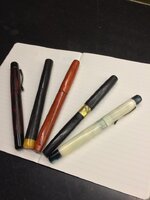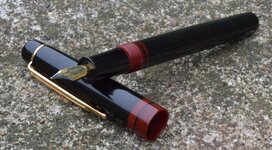Hi,
I'm new to pen turning. Did a few kits and then dove into kitless. It's working out ok - I have 5 workable pens so far, hope the pic comes through (yeah, I made a white ink pen. Not a great idea) I had a few questions for the folks who've been doing this a while:
- I worry about the strength of the wood pens I've made. Does anyone insert brass tubes into these as kitless pens for strength, or is it unevcesary. I think the wood walls are about 2mm.
- does anyone have a good solution for sealing a wood cap so the nib doesn't dry out?
- I'm using m12x1.0 and m10x1.0 for the cap and barrel threads. On the wood pens I use ebonite for the threads and it's fine. On acrylic pens, the acrylic seems really fragile and I get some threads cracking off in use. Does anyone have a favorite set of thread dimensions for this kind of pen?
- one of the pens is ebonite. Really cool (if stinky). But I can't get a high gloss finish on it. Does anyone have a good finish for this material? I guess I could just do standard CA finish?
I'm new to pen turning. Did a few kits and then dove into kitless. It's working out ok - I have 5 workable pens so far, hope the pic comes through (yeah, I made a white ink pen. Not a great idea) I had a few questions for the folks who've been doing this a while:
- I worry about the strength of the wood pens I've made. Does anyone insert brass tubes into these as kitless pens for strength, or is it unevcesary. I think the wood walls are about 2mm.
- does anyone have a good solution for sealing a wood cap so the nib doesn't dry out?
- I'm using m12x1.0 and m10x1.0 for the cap and barrel threads. On the wood pens I use ebonite for the threads and it's fine. On acrylic pens, the acrylic seems really fragile and I get some threads cracking off in use. Does anyone have a favorite set of thread dimensions for this kind of pen?
- one of the pens is ebonite. Really cool (if stinky). But I can't get a high gloss finish on it. Does anyone have a good finish for this material? I guess I could just do standard CA finish?


